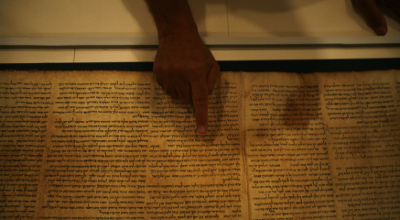Dead Sea Scrolls Exhibit Takes Visitors (Way) Back to the Bible
For those who love to study ancient history, the Dead Sea Scrolls & the Bible: Ancient Artifacts, Timeless Treasures exhibit at Southwestern Baptist Theological Seminary is a must-see. For the average person, it is a once-in-a-lifetime opportunity to view 2,000-year-old Dead Sea Scroll fragments, some of which are on display for the first time.
Discovered in Israel in 1947, the Dead Sea Scrolls are considered by many scholars to be the greatest manuscript discovery of modern times. The Dead Sea Scrolls are 1,000 years older than the oldest complete Hebrew Bible known to man prior to 1947.
The exhibit on display at the SWBTS’ MacGorman Performing Arts Center in Fort Worth, Texas, until Jan. 13, includes 21 scroll fragments of ancient biblical texts from Genesis, Exodus, Leviticus, Numbers, Deuteronomy, 1 Kings, Nehemiah, the Psalms, Isaiah, Jeremiah, Ezekiel, Daniel, Joel, Amos and Jonah. It is the first time 12 of the fragments have been viewed by the general public.
“Some of the scrolls date from the second temple period, back to about 250 B.C.,” McCoy said. “When people come to visit the exhibit, they are not going to get a sealskin or leather-bound issue of the Bible. It is simply a scroll, and we believe that visitors will be fascinated by how old these things really are and their authenticity. We’re humbled to be able to host an exhibit like this.”
Southwestern Baptist Theological Seminary in Fort Worth purchased some of the scroll fragments from the Shahin family in Israel. A Bedouin shepherd first found the scrolls and brought them to Khalil Escander Shahin, known as Kando.
Paige Patterson, president of SWBTS, and his wife, Dorothy, became friends with Kando when they met in Kando’s shop in Bethlehem 40 years ago. Kando since has passed away, but his son, William, reached out to the Pattersons when the family decided to sell some of the scrolls.
Friends of the Pattersons, Gary and Stephanie Loveless, accompanied the couple on one of their trips to Israel and eventually provided the funds to purchase the first few scrolls from Kando’s family.
Other parts of the exhibit include a replica of Jerusalem’s Western Wall, or Wailing Wall, on which visitors can place prayers or praises to God; a portion of a Gutenberg Bible from 1450s Germany; a 1611 King James Bible; an authentic Bedouin tent made of goat hair and interactive kiosks. Other artifacts are loan from entities around the world.
Visitors can also experience what is like to be an archaeologist. On the outside of the MacGorman Center lies the Qumran Simulated Dig Site, in which individuals can participate in an excavation under the supervision of Ph.D. and Master’s level students from SWBTS. The site has been layered with hundreds of 2,000-year-old potsherds, contributed by the Smithsonian Institute.
For more information, click here to visit the exhibit’s website.














































